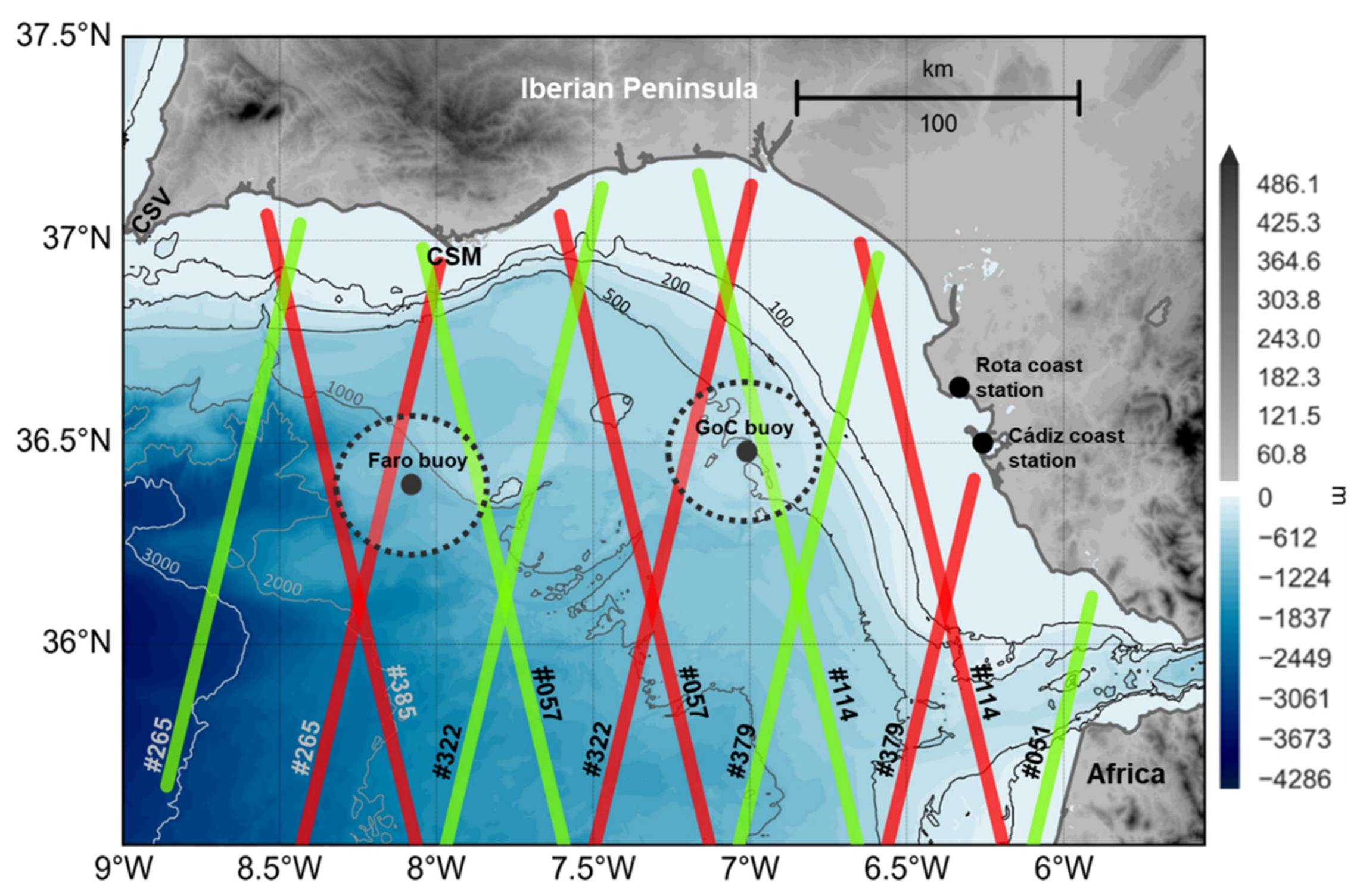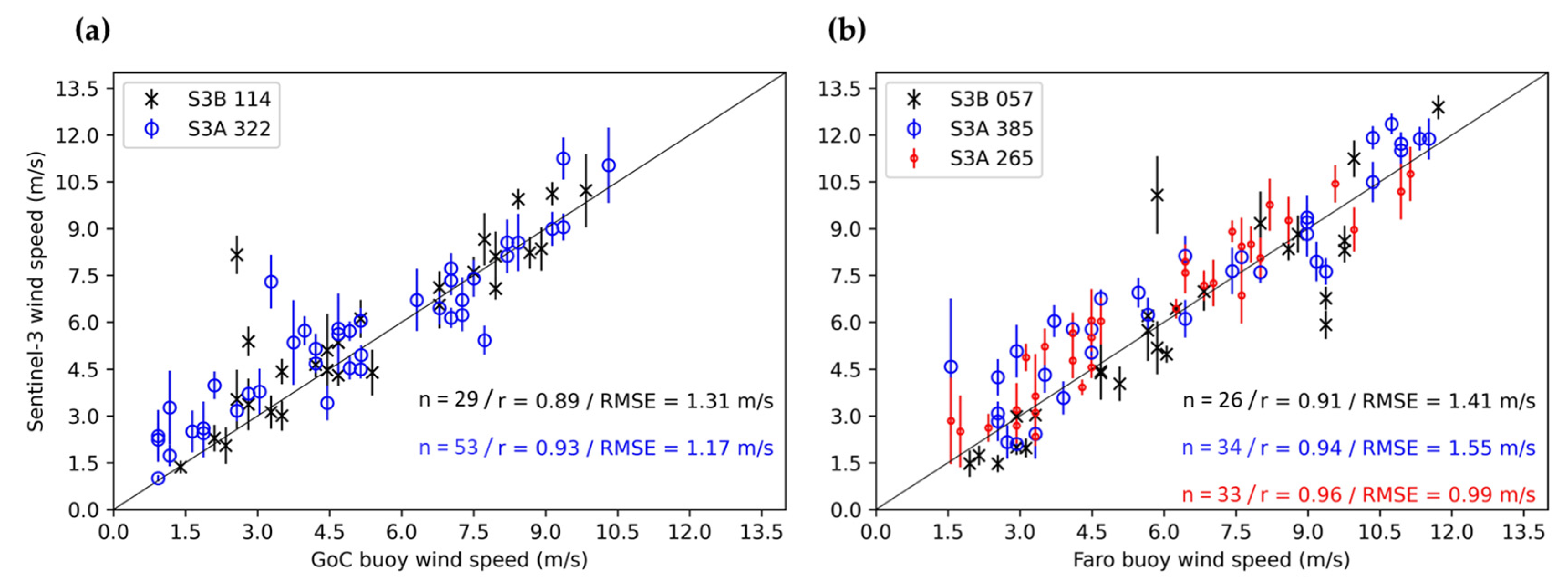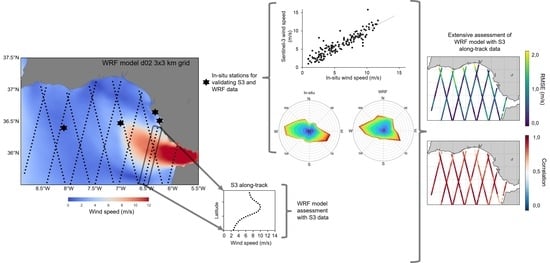The Use of Sentinel-3 Altimetry Data to Assess Wind Speed from the Weather Research and Forecasting (WRF) Model: Application over the Gulf of Cadiz
Abstract
:1. Introduction
2. Materials and Methods
2.1. Study Area
2.2. Altimetry Data
2.3. In Situ Data
2.4. Weather Research and Forecasting Model Data
2.5. Assessment of Altimeter and Model Data
3. Results and Discussion
3.1. Preliminary Validation of the Data Sources
3.1.1. Altimetry Wind Speed Validation Using In Situ Data
3.1.2. WRF Model Wind Velocity Validation against In Situ Data
3.2. WRF Model Spatial Assessment Using Altimetry Data
3.3. Observability of Spatial Variability
4. Conclusions
Author Contributions
Funding
Data Availability Statement
Conflicts of Interest
References
- Kelly, K.A.; Dickinson, S.; Yu, Z. NSCAT Tropical Wind Stress Maps: Implications for Improving Ocean Modeling. J. Geophys. Res. Ocean. 1999, 104, 11291–11310. [Google Scholar] [CrossRef]
- GCOS. The Global Observing System for Climate Implementation Needs. World Meteorol. Organ. 2016, 200, 316. [Google Scholar]
- Cerralbo, P.; Grifoll, M.; Moré, J.; Bravo, M.; Sairouní Afif, A.; Espino, M. Wind Variability in a Coastal Area (Alfacs Bay, Ebro River Delta). Adv. Sci. Res. 2015, 12, 11–21. [Google Scholar] [CrossRef]
- Lu, Y.; Zhang, B.; Perrie, W.; Mouche, A.; Li, X.; Wang, H. A C-Band Geophysical Model Function for Determining Coastal Wind Speed Using Synthetic Aperture Radar. Prog. Electromagn. Res. Symp. 2018, 11, 2417–2428. [Google Scholar] [CrossRef]
- Bôas, A.B.V.; Ardhuin, F.; Ayet, A.; Bourassa, M.A.; Brandt, P.; Chapron, B.; Cornuelle, B.D.; Farrar, J.T.; Fewings, M.R.; Fox-Kemper, B.; et al. Integrated Observations of Global Surface Winds, Currents, and Waves: Requirements and Challenges for the next Decade. Front. Mar. Sci. 2019, 6, 1–34. [Google Scholar] [CrossRef]
- Mulero-Martínez, R.; Gómez-Enri, J.; Mañanes, R.; Bruno, M. Assessment of Near-Shore Currents from CryoSat-2 Satellite in the Gulf of Cádiz Using HF Radar-Derived Current Observations. Remote Sens. Environ. 2021, 256, 112310. [Google Scholar] [CrossRef]
- Rio, M.H.; Mulet, S.; Picot, N. Beyond GOCE for the Ocean Circulation Estimate: Synergetic Use of Altimetry, Gravimetry, and in Situ Data Provides New Insight into Geostrophic and Ekman Currents. Geophys. Res. Lett. 2014, 41, 8918–8925. [Google Scholar] [CrossRef]
- Mears, C.A.; Scott, J.; Wentz, F.J.; Ricciardulli, L.; Leidner, S.M.; Hoffman, R.; Atlas, R. A Near-Real-Time Version of the Cross-Calibrated Multiplatform (CCMP) Ocean Surface Wind Velocity Data Set. J. Geophys. Res. Ocean. 2019, 124, 6997–7010. [Google Scholar] [CrossRef]
- Astudillo, O.; Dewitte, B.; Mallet, M.; Frappart, F.; Rutllant, J.A.; Ramos, M.; Bravo, L.; Goubanova, K.; Illig, S. Surface Winds off Peru-Chile: Observing Closer to the Coast from Radar Altimetry. Remote Sens. Environ. 2017, 191, 179–196. [Google Scholar] [CrossRef]
- Vogelzang, J.; Stoffelen, A.; Lindsley, R.D.; Verhoef, A.; Verspeek, J. The ASCAT 6.25-Km Wind Product. IEEE J. Sel. Top. Appl. Earth Obs. Remote Sens. 2017, 10, 2321–2331. [Google Scholar] [CrossRef]
- Carvalho, D.; Rocha, A.; Gómez-Gesteira, M.; Silva Santos, C. Offshore Winds and Wind Energy Production Estimates Derived from ASCAT, OSCAT, Numerical Weather Prediction Models and Buoys—A Comparative Study for the Iberian Peninsula Atlantic Coast. Renew. Energy 2017, 102, 433–444. [Google Scholar] [CrossRef]
- Korsbakken, E.; Johannessen, J.A.; Johannessen, O.M. Coastal Wind Field Retrievals from ERS SAR Images. In Proceedings of the IGARSS’97. 1997 IEEE International Geoscience and Remote Sensing Symposium Proceedings. Remote Sensing-A Scientific Vision for Sustainable Development, Singapore, 3–8 August 1997; Volume 103, pp. 1211–1216. [Google Scholar] [CrossRef]
- Zhou, L.; Zheng, G.; Li, X.; Yang, J.; Ren, L.; Chen, P.; Zhang, H.; Lou, X. An Improved Local Gradient Method for Sea Surface Wind Direction Retrieval from SAR Imagery. Remote Sens. 2017, 9, 671. [Google Scholar] [CrossRef]
- Mu, S.; Li, X.; Wang, H. The Fusion of Physical, Textural, and Morphological Information in SAR Imagery for Hurricane Wind Speed Retrieval Based on Deep Learning. IEEE Trans. Geosci. Remote Sens. 2022, 60, 1–13. [Google Scholar] [CrossRef]
- Sar, S.C.; Yu, P.; Xu, W.; Zhong, X.; Johannessen, J.A.; Yan, X.; Geng, X.; He, Y.; Lu, W. A Neural Network Method for Retrieving Sea Surface Wind Speed for C-Band SAR. Remote Sens. 2022, 14, 2269. [Google Scholar]
- Abdalla, S. Ku-Band Radar Altimeter Surface Wind Speed Algorithm. Mar. Geod. 2012, 35, 276–298. [Google Scholar] [CrossRef]
- Witter, D.L.; Chelton, D.B. A Geosat Altimeter Wind Speed Algorithm and a Method for Altimeter Wind Speed Algorithm Development. J. Geophys. Res. 1991, 96, 8853–8860. [Google Scholar] [CrossRef]
- Yang, J.; Zhang, J.; Jia, Y.; Fan, C.; Cui, W. Validation of Sentinel-3A/3B and Jason-3 Altimeter Wind Speeds and Significant Wave Heights Using Buoy and ASCAT Data. Remote Sens. 2020, 12, 2079. [Google Scholar] [CrossRef]
- Quartly, G.D.; Nencioli, F.; Raynal, M.; Bonnefond, P.; Garcia, P.N.; Garcia-Mondéjar, A.; de la Cruz, A.F.; Cretaux, J.F.; Taburet, N.; Frery, M.L.; et al. The Roles of the S3MPC: Monitoring, Validation and Evolution of Sentinel-3 Altimetry Observations. Remote Sens. 2020, 12, 1763. [Google Scholar] [CrossRef]
- Abdalla, S.; Centre (MPC) for the Copernicus. Sentinel-3 Mission S3 Wind and Waves Cyclic Performance Report; Cycle No. 066-A End Date: 31 December 2020 Cycle No. 047-B; European Space Agency: Paris, France, 2021. [Google Scholar]
- Powers, J.G.; Klemp, J.B.; Skamarock, W.C.; Davis, C.A.; Dudhia, J.; Gill, D.O.; Coen, J.L.; Gochis, D.J.; Ahmadov, R.; Peckham, S.E.; et al. The Weather Research and Forecasting Model: Overview, System Efforts, and Future Directions. Bull. Am. Meteorol. Soc. 2017, 98, 1717–1737. [Google Scholar] [CrossRef]
- Skamarock, W.C.; Klemp, J.B.; Dudhia, J.; Gill, D.O.; Zhiquan, L.; Berner, J.; Wang, W.; Powers, J.G.; Duda, M.G.; Barker, D.M.; et al. A Description of the Advanced Research WRF Model Version 4; National Center for Atmospheric Research: Boulder, CO, USA, 2019; Volume 145, p. 145. [Google Scholar]
- Bhowmick, S.A.; Modi, R.; Sandhya, K.G.; Seemanth, M.; Balakrishnan Nair, T.M.; Kumar, R.; Sharma, R. Analysis of SARAL/AltiKa Wind and Wave over Indian Ocean and Its Real-Time Application in Wave Forecasting System at ISRO. Mar. Geod. 2015, 38, 396–408. [Google Scholar] [CrossRef]
- Carvalho, D.; Rocha, A.; Gómez-Gesteira, M.; Silva Santos, C. Sensitivity of the WRF Model Wind Simulation and Wind Energy Production Estimates to Planetary Boundary Layer Parameterizations for Onshore and Offshore Areas in the Iberian Peninsula. Appl. Energy 2014, 135, 234–246. [Google Scholar] [CrossRef]
- Peliz, A.; Dubert, J.; Marchesiello, P.; Teles-Machado, A. Surface Circulation in the Gulf of Cadiz: Model and Mean Flow Structure. J. Geophys. Res. Ocean. 2007, 112, C11015. [Google Scholar] [CrossRef]
- Navarro, G.; Escudier, R.; Pascual, A.; Caballero, I.; Vázquez, A. Singular Value Decomposition of Ocean Surface Chlorophyll and Sea Level Anomalies in the Gulf of Cadiz (South-Western Iberian Peninsula). In Proceedings of the 20 Years of Progress in Radar Altimetry Conference, Venice, Italy, 24–29 September 2012. [Google Scholar]
- Garel, E.; Laiz, I.; Drago, T.; Relvas, P. Characterisation of Coastal Counter-Currents on the Inner Shelf of the Gulf of Cadiz. J. Mar. Syst. 2016, 155, 19–34. [Google Scholar] [CrossRef]
- Hernández-Ceballos, M.A.; Adame, J.A.; Bolívar, J.P.; De la Morena, B.A. A Mesoscale Simulation of Coastal Circulation in the Guadalquivir Valley (Southwestern Iberian Peninsula) Using the WRF-ARW Model. Atmos. Res. 2013, 124, 1–20. [Google Scholar] [CrossRef]
- Folkard, A.M.; Davies, P.A.; Fiúza, A.F.G.; Ambar, I. Remotely Sensed Sea Surface Thermal Patterns in the Gulf Of-Cadiz and the Strait of Gibraltar: Variability, Correlations, and Relationships with the Surface Wind Field. J. Geophys. Res. Ocean. 1997, 102, 5669–5683. [Google Scholar] [CrossRef]
- Hidalgo, P.; Gallego, D. A Historical Climatology of the Easterly Winds in the Strait of Gibraltar. Atmosfera 2019, 32, 181–195. [Google Scholar] [CrossRef]
- Brandt, P.; Rubino, A.; Sein, D.V.; Baschek, B.; Izquierdo, A.; Backhaus, J.O. Sea Level Variations in the Western Mediterranean Studied by a Numerical Tidal Model of the Strait of Gibraltar. J. Phys. Oceanogr. 2004, 34, 433–443. [Google Scholar] [CrossRef]
- Ross, T.; Garrett, C.; Traon, P.Y. Le Western Mediterranean Sea-Level Rise: Changing Exchange Flow through the Strait of Gibraltar. Geophys. Res. Lett. 2000, 27, 2949–2952. [Google Scholar] [CrossRef]
- Gómez-Enri, J.; González, C.J.; Passaro, M.; Vignudelli, S.; Álvarez, O.; Cipollini, P.; Mañanes, R.; Bruno, M.; López-Carmona, M.P.; Izquierdo, A. Wind-Induced Cross-Strait Sea Level Variability in the Strait of Gibraltar from Coastal Altimetry and in-Situ Measurements. Remote Sens. Environ. 2019, 221, 596–608. [Google Scholar] [CrossRef]
- Aldarias, A.; Gomez-Enri, J.; Laiz, I.; Tejedor, B.; Vignudelli, S.; Cipollini, P. Validation of Sentinel-3A SRAL Coastal Sea Level Data at High Posting Rate: 80 Hz. IEEE Trans. Geosci. Remote Sens. 2020, 58, 3809–3821. [Google Scholar] [CrossRef]
- Gómez-Enri, J.; Vignudelli, S.; Cipollini, P.; Coca, J.; González, C.J. Validation of CryoSat-2 SIRAL Sea Level Data in the Eastern Continental Shelf of the Gulf of Cadiz (Spain). Adv. Space Res. 2018, 62, 1405–1420. [Google Scholar] [CrossRef]
- Bouffard, J.; Pascual, A.; Ruiz, S.; Faugère, Y.; Tintoré, J. Coastal and Mesoscale Dynamics Characterization Using Altimetry and Gliders: A Case Study in the Balearic Sea. J. Geophys. Res. Ocean. 2010, 115, 1–17. [Google Scholar] [CrossRef]
- Meloni, M.; Bouffard, J.; Doglioli, A.M.; Petrenko, A.A.; Valladeau, G. Toward Science-Oriented Validations of Coastal Altimetry: Application to the Ligurian Sea. Remote Sens. Environ. 2019, 224, 275–288. [Google Scholar] [CrossRef]
- Paulson, C.A. The Mathematical Representation of Wind Speed and Temperature Profiles in the Unstable Atmospheric Surface Layer. J. Appl. Meteorol. 1970, 9, 857–861. [Google Scholar] [CrossRef]
- Powell, M.D.; Vickery, P.J.; Reinhold, T.A. Reduced Drag Coefficient for High Wind Speeds in Tropical Cyclones. Nature 2003, 422, 279–283. [Google Scholar] [CrossRef]
- Carvalho, D.; Rocha, A.; Gómez-Gesteira, M.; Santos, C. A Sensitivity Study of the WRF Model in Wind Simulation for an Area of High Wind Energy. Environ. Model. Softw. 2012, 33, 23–34. [Google Scholar] [CrossRef]
- De Kloe, J.; Stoffelen, A.; Verhoef, A. Improved Use of Scatterometer Measurements by Using Stress-Equivalent Reference Winds. IEEE J. Sel. Top. Appl. Earth Obs. Remote Sens. 2017, 10, 2340–2347. [Google Scholar] [CrossRef]
- Emeis, S.; Turk, M. Comparison of Logarithmic Wind Profiles and Power Law Wind Profiles and Their Applicability for Offshore Wind Profiles. In Wind Energy; Springer: Berlin/Heidelberg, Germany, 2007; pp. 61–64. [Google Scholar] [CrossRef]
- Peña, A.; Gryning, S.E.; Hasager, C.B. Measurements and Modelling of the Wind Speed Profile in the Marine Atmospheric Boundary Layer. Bound.-Layer Meteorol. 2008, 129, 479–495. [Google Scholar] [CrossRef]
- Arasa, R.; Porras, I.; Domingo-Dalmau, A.; Picanyol, M.; Codina, B.; González, M.Á.; Piñón, J. Defining a Standard Methodology to Obtain Optimum WRF Configuration for Operational Forecast: Application over the Port of Huelva (Southern Spain). Atmos. Clim. Sci. 2016, 6, 329–350. [Google Scholar] [CrossRef]
- Salvação, N.; Guedes Soares, C. Wind Resource Assessment Offshore the Atlantic Iberian Coast with the WRF Model. Energy 2018, 145, 276–287. [Google Scholar] [CrossRef]
- Li, H.; Claremar, B.; Wu, L.; Hallgren, C.; Körnich, H.; Ivanell, S.; Sahlée, E. A Sensitivity Study of the WRF Model in Offshore Wind Modeling over the Baltic Sea. Geosci. Front. 2021, 12, 101229. [Google Scholar] [CrossRef]
- Marta-Almeida, M.; Teixeira, J.C.; Carvalho, M.J.; Melo-Gonçalves, P.; Rocha, A.M. High Resolution WRF Climatic Simulations for the Iberian Peninsula: Model Validation. Phys. Chem. Earth Parts A/B/C 2016, 94, 94–105. [Google Scholar] [CrossRef]
- Carvalho, D.; Rocha, A.; Gómez-Gesteira, M. Ocean Surface Wind Simulation Forced by Different Reanalyses: Comparison with Observed Data along the Iberian Peninsula Coast. Ocean Model. 2012, 56, 31–42. [Google Scholar] [CrossRef]
- Stoffelen, A. Toward the True Near-Surface Wind Speed: Error Modeling and Calibration Using Triple Collocation. J. Geophys. Res. Ocean. 1998, 103, 7755–7766. [Google Scholar] [CrossRef]
- Passaro, M.; Cipollini, P.; Vignudelli, S.; Quartly, G.D.; Snaith, H.M. ALES: A Multi-Mission Adaptive Subwaveform Retracker for Coastal and Open Ocean Altimetry. Remote Sens. Environ. 2014, 145, 173–189. [Google Scholar] [CrossRef]
- Adame, J.A.; Lope, L.; Hidalgo, P.J.; Sorribas, M.; Gutiérrez-Álvarez, I.; del Águila, A.; Saiz-Lopez, A.; Yela, M. Study of the Exceptional Meteorological Conditions, Trace Gases and Particulate Matter Measured during the 2017 Forest Fire in Doñana Natural Park, Spain. Sci. Total Environ. 2018, 645, 710–720. [Google Scholar] [CrossRef]
- Ngan, F.; Kim, H.; Lee, P.; Al-Wali, K.; Dornblaser, B. A Study of Nocturnal Surface Wind Speed Overprediction by the WRF-ARW Model in Southeastern Texas. J. Appl. Meteorol. Climatol. 2013, 52, 2638–2653. [Google Scholar] [CrossRef]
- Misaki, T.; Ohsawa, T.; Konagaya, M.; Shimada, S.; Takeyama, Y.; Nakamura, S. Accuracy Comparison of Coastal Wind Speeds between WRF Simulations Using Different Input Datasets in Japan. Energies 2019, 12, 2754. [Google Scholar] [CrossRef]
- Román-Cascón, C.; Lothon, M.; Lohou, F.; Hartogensis, O.; Vila-Guerau De Arellano, J.; Pino, D.; Yagüe, C.; Pardyjak, E.R. Surface Representation Impacts on Turbulent Heat Fluxes in the Weather Research and Forecasting (WRF) Model (v.4.1.3). Geosci. Model Dev. 2021, 14, 3939–3967. [Google Scholar] [CrossRef]







| Sentinel 3A | Sentinel 3B | ||||||
|---|---|---|---|---|---|---|---|
| Relative Orbit | N° Cycles S3A vs. WRF | N° Cycles S3A vs. Buoy | Orientation | Relative Orbit | N° Cycles S3B vs. WRF | N° Cycles S3B vs. Buoy | Orientation |
| #057 | 13 | - | A | #051 | 14 | - | D |
| #114 | 13 | - | A | #057 | 14 | 26 | A |
| #265 | 14 | 33 | D | #114 | 14 | 29 | A |
| #322 | 14 | 53 | D | #265 | 13 | - | D |
| #379 | 14 | - | D | #322 | 13 | - | D |
| #385 | 14 | 34 | A | #379 | 13 | - | D |
| Analysed period | From January 2020 to December 2020 | From January 2017 to December 2020 | From January 2020 to December 2020 | From November 2018 to December 2020 | |||
| Scheme or Parameterization | Selected Option |
|---|---|
| Initialization | NCEP/NARC GFS 0.25° |
| Microphysics | SBU-Lin |
| Longwave radiaion | RRTMG |
| Shortwave radiation | Dudhia |
| Cumulus | Kain-Fritsch |
| Surface layer | MM5 similarity |
| Planetary boundary layer | YSU |
| Vertical levels number | 36 |
| Diffusion 6th order option | Knievel |
| Damping | Rayleigh |
| Topography model | GTOPO30 |
| Land uses | GLC |
| Nudging | Grid nudging (d01)/Observational nudging (d02) |
| Sea surface temperature | Updated every 6 h |
| Wind Speed | Wind Direction | |||||
|---|---|---|---|---|---|---|
| In Situ Station | Bias (m/s) | RMSE (m/s) | NRMSE (m/s) | r | Bias (°) | STDE (°) |
| GoC buoy | 0.74 | 1.93 | 0.12 | 0.80 | 6.74 | 47.10 |
| Cádiz coast station | −0.13 | 1.74 | 0.12 | 0.74 | 5.78 | 54.49 |
| Rota coast station | 0.44 | 1.65 | 0.16 | 0.74 | 8.35 | 48.68 |
| Faro buoy | 0.33 | 1.59 | 0.10 | 0.85 | 5.54 | 33.84 |
Publisher’s Note: MDPI stays neutral with regard to jurisdictional claims in published maps and institutional affiliations. |
© 2022 by the authors. Licensee MDPI, Basel, Switzerland. This article is an open access article distributed under the terms and conditions of the Creative Commons Attribution (CC BY) license (https://creativecommons.org/licenses/by/4.0/).
Share and Cite
Mulero-Martinez, R.; Román-Cascón, C.; Mañanes, R.; Izquierdo, A.; Bruno, M.; Gómez-Enri, J. The Use of Sentinel-3 Altimetry Data to Assess Wind Speed from the Weather Research and Forecasting (WRF) Model: Application over the Gulf of Cadiz. Remote Sens. 2022, 14, 4036. https://doi.org/10.3390/rs14164036
Mulero-Martinez R, Román-Cascón C, Mañanes R, Izquierdo A, Bruno M, Gómez-Enri J. The Use of Sentinel-3 Altimetry Data to Assess Wind Speed from the Weather Research and Forecasting (WRF) Model: Application over the Gulf of Cadiz. Remote Sensing. 2022; 14(16):4036. https://doi.org/10.3390/rs14164036
Chicago/Turabian StyleMulero-Martinez, Roberto, Carlos Román-Cascón, Rafael Mañanes, Alfredo Izquierdo, Miguel Bruno, and Jesús Gómez-Enri. 2022. "The Use of Sentinel-3 Altimetry Data to Assess Wind Speed from the Weather Research and Forecasting (WRF) Model: Application over the Gulf of Cadiz" Remote Sensing 14, no. 16: 4036. https://doi.org/10.3390/rs14164036
APA StyleMulero-Martinez, R., Román-Cascón, C., Mañanes, R., Izquierdo, A., Bruno, M., & Gómez-Enri, J. (2022). The Use of Sentinel-3 Altimetry Data to Assess Wind Speed from the Weather Research and Forecasting (WRF) Model: Application over the Gulf of Cadiz. Remote Sensing, 14(16), 4036. https://doi.org/10.3390/rs14164036








